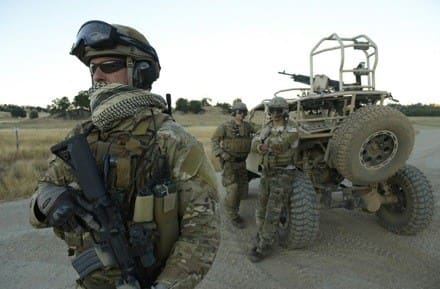The Air Force has extended the response date for their Tactical Capabilities for Battlefield Airmen and Security Forces Broad Agency Announcement through 30 October of 2012.
For those of you unfamiliar with the term ‘Battlefield Airman,’ they are essentially the USAF’s ground forces.
Certain ground combat capabilities are an Airman’s responsibility and require unique surface operations that are integral to the application of air and space power. To meet this responsibility, the Air Force recognized the need to organize, train, and equip a force of Battlefield Airmen (BA) capable of delivering distinctive expertise in a ground combat environment with unequaled firepower, accuracy, responsiveness, flexibility and persistence. These BA include Combat Control, Pararescue, Tactical Air Control and Battlefield Weather professionals. BA provide skill sets not commonly found across the Air Force and typically operate in combat zones outside the perimeter of Air Force bases, often in the deep battle space.
Naturally, Security Forces are the Air Force’s security troops and the provide air base ground defense as well as law enforcement support. They also happen to be the largest enlisted career field in the Air Force. Additionally, Security Forces in particular holds great influence over how the rest of the Air Force’s personnel are armed and equipped for personal protection and collective air base defense.
For the purposes of the BAA, “Research includes scientific study and experimentation directed at developing technologies, components, and quick reaction capabilities (QRC). This work includes tactical level Command, Control, Communications, Computers, Intelligence, Surveillance and Reconnaissance (C4ISR), threat intercept, and force application capabilities for Battlefield Airmen and Security Forces. Potential areas of interest include tactical level targeting applications such as wireless network applications, line-of-sight and beyond-line-of-sight communication links, remote sensing, remote switching, target tagging, tactical command and control of ground forces, tactical electrical energy, small Unmanned Aerial Systems, and general improvements in situational awareness, targeting, force protection/fractricide prevention, and damage assessment.”
But, having said that, there are 10 research areas of interest and most if not all are within the purview of the companies that read SSD –
RESEARCH AREA 1 – FORCE PROTECTION ENHANCEMENTS
RESEARCH AREA 2 – PERSONAL EQUIPMENT
RESEARCH AREA 3 – C4 SYSTEMS AND RELATED SOFTWARE
RESEARCH AREA 4 – OPTICS AND DISPLAYS
RESEARCH AREA 5 – NAVAIDS AND SENSORS
RESEARCH AREA 6 – TACTICAL ENERGY
RESEARCH AREA 7 – CLANDESTINE MOBILITY
RESEARCH AREA 8 – MEDICAL
RESEARCH AREA 9 – TACTICAL METEOROLOGICAL SYSTEMS
RESEARCH AREA 10 – ALTERNATE MEANS OF INSERTION AND EXTRACTION
To give you an idea of what types of things they are interested in, here is the description of the Personal Equipment research area.
The goal of this work is to perform basic and applied research in the area of personal equipment items to improve the capabilities and effectiveness of the battlefield airman. The objective is to conduct research which could eventually lead to the development of personal garments, body armor, eye protection and mission related personal items. Research in garments that will aid in camouflage, disguise, deception and concealment while preventing contamination and/or injury or exposure to Chemical, Biological, Radiological, Nuclear and Explosives (CBRNE) threats may be proposed. In addition, research in the area of enhanced personal performance through improved nutrition, supplements and sustenance may also be proposed.
Full descriptions for all research areas are available at the link.
In all cases, the first step is a white paper. For full details visit www.fbo.gov.

















































































































